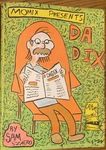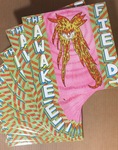
edited by Ivan Brunetti It's too early to say for certain, but this follow-up to Brunetti's already classic 2006 anthology, also published by Yale University Press, might just be even better than its precursor. One thing's for certain: Brunetti has held onto -- and further refined -- his editorial vision of arranging the work contained in this volume in an organic sequence, deftly managing to map out the similarities between artists so that each piece flows smoothly into into the other, creating an amazing sense of an innate connectivity between all areas of comics here on display. This book is a powerful ally in the struggle to bring the light of comics to those poor souls still dwelling in the darkness. It's the perfect choice to turn on a friend or relative to the joy, beauty and pleasures of our favorite medium. Hold onto your hats, here's the contributor list: Daniel Clowes, Saul Steinberg, Sammy Harkham, Chris Ware, R. Sikoryak, Michael Kupperman, Drew Friedman, Mark Beyer, Mack White, Jayr Pulga, Renee French, Kim Deitch, Richard Sala, J. Bradley Johnson, Archer Prewit, Anonymous (utility sketchbook), HJ Tuthill, Milt Gross, Bill Holman, Harvey Kurtzman, R.Crumb, Basil Wolverton, Art Spiegelman, Jess, John Hankiewicz, Tim Hensley, Bill Griffith, Richard McGuire, Gilbert Hernandez, Jim Woodring, David Collier, Eugene Teal, Charles Burns, Karl Wirsum, Gary Panter, Paper Rad, Fletcher Hanks, CF, Charles Forbell, Ron Rege, Jr., Winsor McCay, Matthew Thurber, Souther Salazar, Kevin Scalzo, Megan Kelso, James McShane, Laura Park, Vanessa Davis, Onsmith, Joe Matt, Jeffrey Brown, Martin Cendreda, Dave Kiersh, John Porcellino, Carrie Golus/Patrick Welch, Jessica Abel, Cole Johnson, Lynda Barry, Debbie Drechsler, Diane Noomin, Aline Kominsky-Crum, Ariel Bordeaux, Chester Brown, Anders Nilsen, Joe Sacco, Phoebe Gloeckner, Elinore Norflus, Brian Chippendale, Leif Goldberg, David Mazzuchelli, Jerry Moriarty, Ben Katchor, Frank Santoro, Dan Zettwoch, Kevin Huizenga, Harvey Pekar/R.Crumb, Carol Tyler, Maurice Vellekoop, Seth, Adrian Tomine, Jaime Hernandez & David Heatley. It's simply amazing. Comics Power! PLEASE NOTE: We feel compelled to mention that this volume includes several pieces that contain quite explicit sexual content; and while this content represents only a miniscule fraction of the total, it nevertheless renders this volume fit for ADULTS ONLY.

Finally, it's here: the most anticipated release of 2004 (so far). Striving for objet d'art status, McSweeney's 13 comes as close as any comics release to attaining it. Starting with a dust jacket that folds out into a two sided comics poster: the outer side featuring a dense full color, 360º narrative by editor and comics fiend, Chris Ware; the inner side featuring a vaguely ceremonial (think Mayan) worshipping of the idols of comics by Gary Panter. But there's more: tucked into the folds of this dust-jacket-cum-suitable-for-framing-wall-art are two mini-comics commissioned especially for this issue; one -- in full color -- by Ron Rege, Jr., and the other in B & W (as it should be) by long time mini-master, John Porcellino. And that's just the dust jacket! Moving on to the front and back binding plates (the hard covers beneath the dust jacket), we have a hundred or so images culled from a 1936 guide to cartooning separated by a lavishly embossed spine. The end papers are by Ivan Brunetti, and feature a wallpaper of minimalistic renditions of his personal comics and cartoon hall of fame. And, finally, there is the contents of the book itself. The subject of much speculation as to whether it would be reprints or newly commissioned work, the answer is... Both! About half and half, depending on how you look at it. Here's how it breaks down: Some of the work has appeared in non-comics periodicals, but is collected herein for the first time. Under this category are Mark Beyer, Ivan Brunetti, Kaz, Art Spiegelman (although his pieces are being reprinted everywhere at this point) and some of the pieces by Chris Ware. Straight out reprints are the inclusions by Charles Burns (although the frontispiece is new), Chester Brown, Debbie Drechsler, Jaime and Gilberto Hernandez, Mark Newgarden, Archer Prewitt, Joe Sacco, Richard Sala (newly colored, however), Seth, and Adrian Tomine. New to us -- and therefore, we imagine, new to you as well -- are the works by Lynda Barry, Jeffrey Brown, Dan Clowes, David Collier, R. Crumb, Kim Deitch, Julie Doucet, David Heatley, Ben Katchor, Joe Matt, Richard McGuire, Gary Panter, some of the Chris Ware, and of course the aforementioned dust-jacket and minis. In addition to all this contemporary work, there are selections of classic and archival work sprinkled throughout: First and foremost among these is a 15-page spread on "the inventor of comics," Rodolphe Töpfler, and his first appearance in America, introduced by Chris Ware; an 80% reproduction of an original 1922 Mutt and Jeff daily strip by Bud Fisher that takes four pages to display (which gives you an idea of how big they drew comics back then!); and a nine page spread on George Herriman, introduced by Tim Samuelson and featuring Herriman's last Krazy Kat dailies, also reproduced from the originals. And, as if this weren't enough, there are two appreciations by Chris Ware, one of the abstract-expressionist-turned-representational-painter-with-a-personal-affinity-for-comics-iconography, Philip Guston, and the other of Peanuts creator, Charles Schulz. In addition there is a critical appreciation of comics from John Updike, and nostalgiac/elegiac remembrances of comics related experiences by Glen David Gold, Malachi Cohen, and Chip Kidd. The volume opens with a preface from Ira Glass, followed by an introduction by Chris Ware, who, when all is said and done, is clearly more than simply the editor of this work. This is a great piece, especially when you consider it's primary purpose: preaching to the unconverted, those countless, teeming millions out there in America and beyond who don't locate the foundation of their identity in comics. With this volume, McSweeney's begins a new ambitious distribution arrangement with Publisher's Group West in the USA and Penguin Books in the UK; thereby bringing their publications before a great many more potential readers. They couldn't have chosen a better volume to initiate this venture. Let's wish them luck.
ONE COPY (NM; includes both the Porcellino and Regé mini-comics)

Twenty-five years ago, in Raw, Volume 2, Number 1, Richard McGuire published a six-page work, titled "Here"*, and comics have never been the same since. Now, McGuire has expanded his revelation into a full length work, that, while it may be considered to fulfill the definition of graphic novel, is clearly something more besides. Years in the making, Here is a meditation on time and its passage through place that employs the power of comics to concisely and powerfully convey their inextricable relation. Reading Here, one is quickly gripped by a feeling of the uncanny. The realization that the precise spatial coordinates occupied by the room which we are currently occupying as we sit reading has existed for billions of years and that our physical surroundings, which seem so concrete and fixed, are as fleeting and effervescent as clouds passing overhead when subjected to the fullness of time, and, what's more, that somehow all these different moments that flow through this space, one after the other for as close to eternity as it is possible for us to imagine, as a result of the room's seeming fixity, must all exist together, linked in some way through their sharing of the space, delivers a knockout punch to many an unexamined assumption. Thoughts of ghosts, spirits and haunting suddenly seem completely natural: "Of course!" William Faulkner's dictum, "The past isn't dead. It isn't even past," is now seen in a more clinical, immediate light. Here; it is, now. * [sample page]

This chunky little book contains 250+ individual (very) clean line drawings – each appearing alone on its own, faced by a blank, numbered page, for maximum concentrated focus on each single drawing – by the masterful designer/illustrator/comics-maker who brought us the startlingly original Here, Richard McGuire. The volume leads off with an erudite introduction by fellow New Yorker contributor, Luc Sante, that serves, among other things, to help put McGuire's drawings in a specific cultural / art historical context, after which we are treated to the simple joys of following a sequence of drawings to see where it goes; 28 discrete – and ingenious – sequences in all, each with a unique twist. More fun than you might think!










